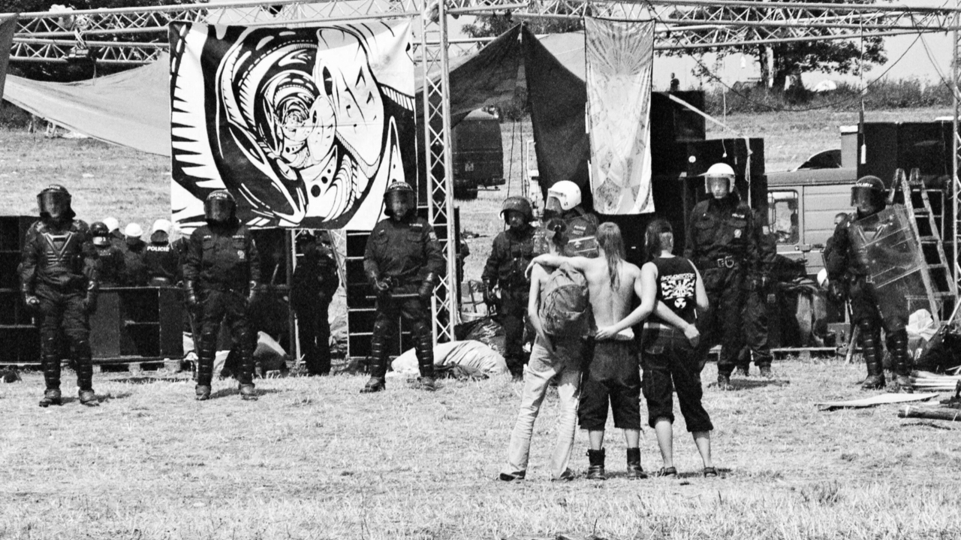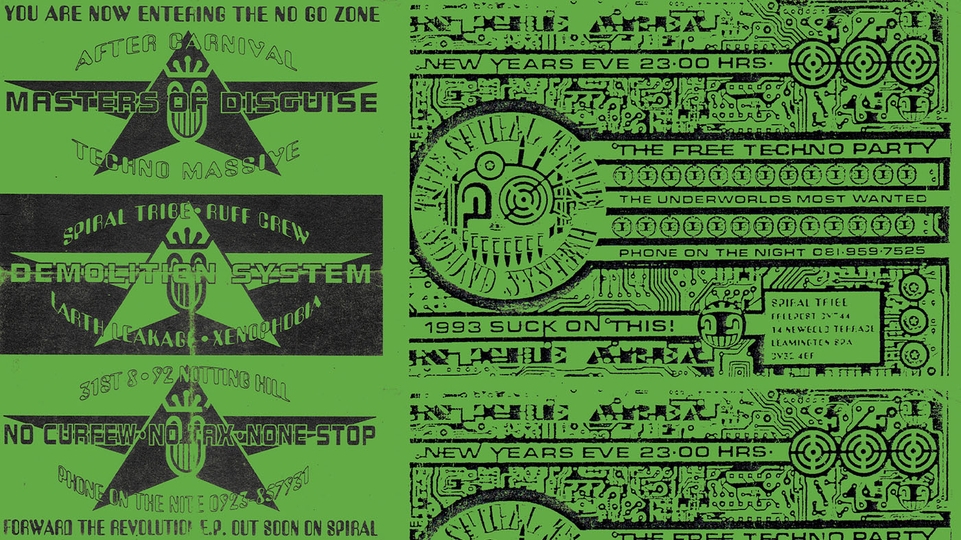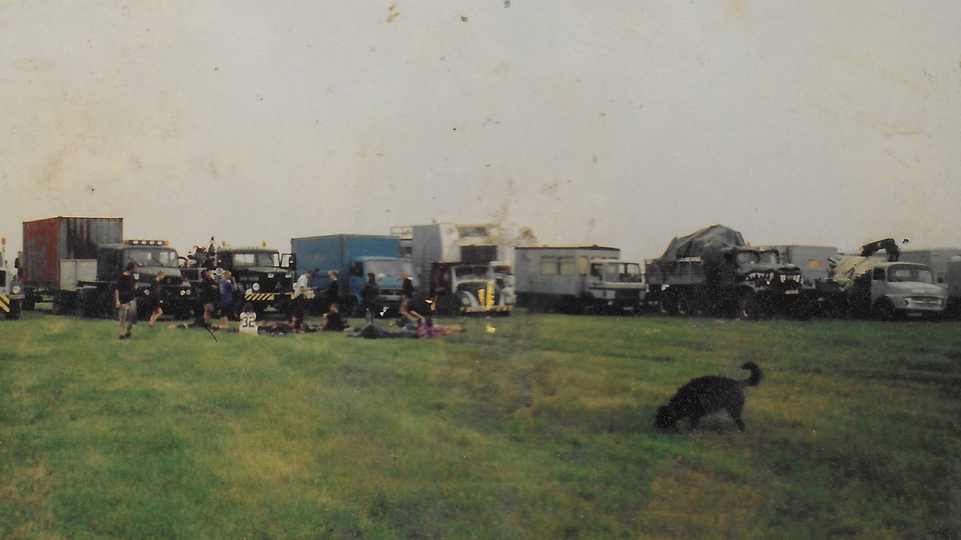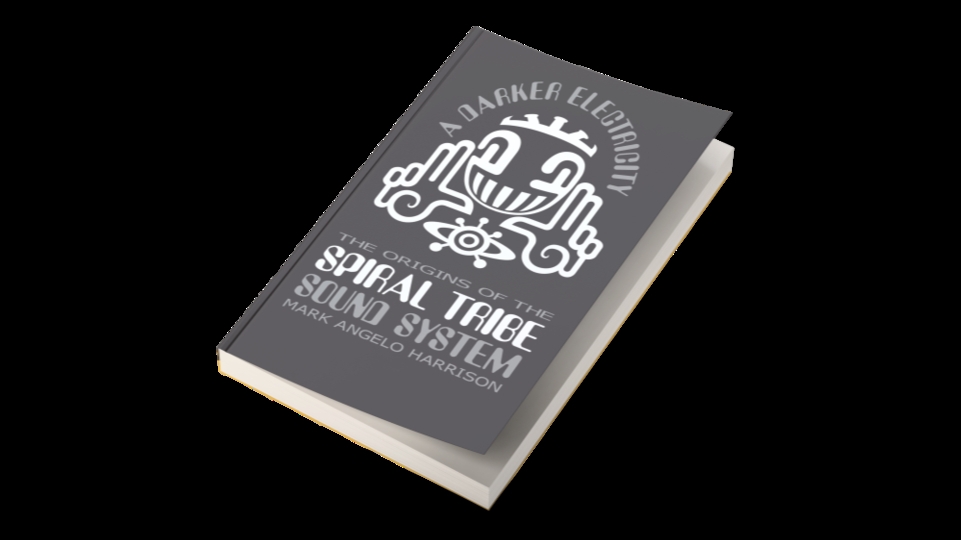
Dance in protest: 30 years of the UK's anti-rave Criminal Justice Bill
1st May 1994 was the first big London protest against the looming Criminal Justice Bill, the piece of legislation that first proscribed a genre of music — rave music, “wholly or predominantly categorised by the emission of a succession of repetitive beats” — in law. Despite widespread demonstrations at what was seen as draconian power-grabs by the UK authorities, the Bill became law later in 1994. Here, Harold Heath looks back at the reaction from the dance music community at the time, and the Act’s lasting impact on the rave scene today
The Criminal Justice and Public Order Act was passed into UK law in November 1994. Infamous for targeting events that played music “wholly or predominantly characterised by the emission of a succession of repetitive beats”, the act gave the police sweeping new powers to “remove persons attending or preparing for a rave” — yes, they actually legislated specifically against raves.
A rave was defined as any gathering of ten people or more; police could order such gatherings to disperse, and could turn back anyone within a mile radius, with three-month prison sentences or £2,500 fines for non-compliance. The bill also targeted, amongst other things, squatters, eco-protesters, hunt saboteurs and so-called ‘new age’ travellers, as though the ruling Conservative Party had launched an attack on every single subculture that they felt somehow threatened traditional British decency and law and order.
The Criminal Justice Bill (soon abbreviated to ‘CJB’ - it was a ‘bill’ before it was passed, an ‘act' after) was an ill-thought-out, rushed and vindictive reaction to — chiefly — the legendary Castlemorton festival in spring ’92. For a week, between 20 and 30 thousand people (estimates vary) took part in one of the single most beautiful expressions of dance music’s power to create community — or took part in the end of civilisation as we know it via the ‘Evil acid house cult’ (TM The Sun newspaper), depending on your point of view.
At the time, the co-founder of DiY Sound System, Grace Sands, was one half of DJ duo Digs (Grace) and Woosh (Pete Birch RIP). “The CJB was the response to the Castlemorton Festival,” she recalls. “DiY Sound System were there, playing house, funk and disco, alongside Spiral Tribe, Circus Warp, Circus Normal and other sound systems playing tougher ravey sounds and techno. It was a huge, fun, illegal gathering with waves of people coming over the weekend to shake a booty and get wild. The powers that be weren't impressed at all! It was bittersweet that such a great week could have such a negative reaction.”
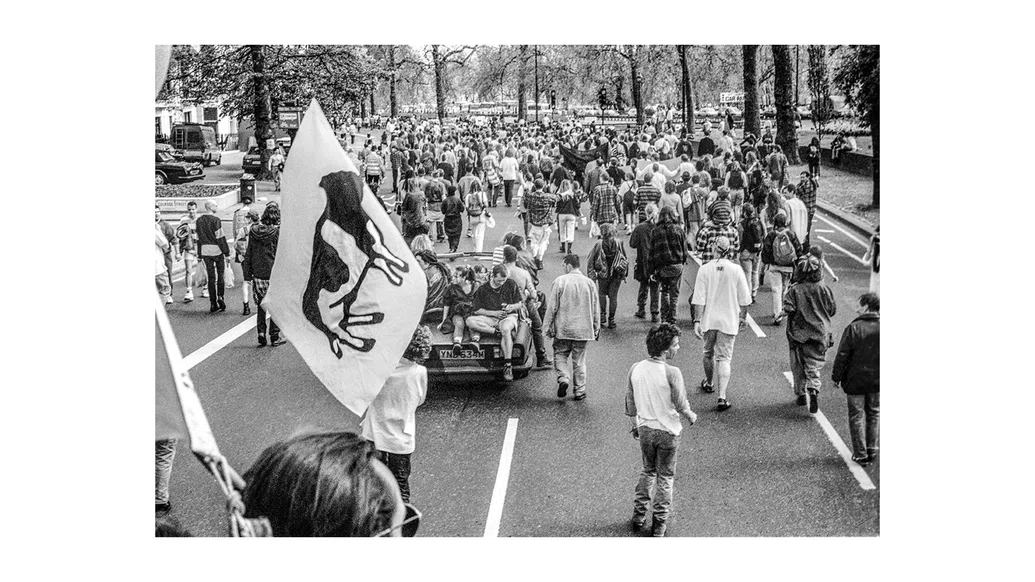
“It was a knee-jerk reaction from an establishment shit-scared that 'we’ — a mixed bunch of townies, crusties, clubbers, ravers, gays and straights — could organise ourselves that well.” – Grace Sands, Digs & Woosh
Simone ‘Sim Simmer’ Feeney, Spiral Tribe co-founder and the Tribe’s MC, felt the full weight of the state’s attention following Castlemorton. “We were just a bunch of ravers that wanted their music to go on a bit longer than we were allowed to,” she remembers, “but just from that small action we felt the wrath of politics breathing down our necks, and the reactions at the time were just crazy.”
Those reactions included police becoming more heavy-handed, like when they violently broke up one of Spiral Tribe’s parties in ’92 using a JCB industrial digger to smash through a wall. Tribe DJ and producer Ixindamix was there that night too. “We got beaten up by riot police at a party in Acton Lane in April 1992,” she tells DJ Mag. “It was most certainly police and government intervention — starting at Acton and culminating with having the sound system, trucks and all our possessions confiscated after being arrested leaving Castlemorton — that influenced our decision to leave Britain in order to go party elsewhere.”
The Criminal Justice Bill (CJB) was the latest in a series of government attempts to end illegal raves, following the failure of the Entertainments (Increased Penalties) Act in July 1990 to have much effect at all, as demonstrated by the flourishing illegal rave scene in ’91/‘92. “The movement had grown across the summer from ’91 to '92 when all the raves moved outside,” Simone says, “and we’d joined up with the travellers and reignited the flame of the free festivals. And then obviously Castlemorton was massive and put the fear of God into the authorities, which is why they took us to court — it was all a political stitch-up.” Following one of the most expensive trials in UK history, in 1994, all 13 Spiral Tribe members who’d been arrested after Castlemorton were found innocent. “And it was shortly after that,” Simone recalls, “that they introduced the Criminal Justice Bill.”
It’s difficult not to view the sections of the act that dealt with raves as a demonstration of how fearful the government were at the sight of thousands of young, often working class people organising themselves through self-made, covert networks and gathering together, often on the land of the Conservative gentry. Grace attempts to sum it up: “It was a knee-jerk reaction from an establishment shit-scared that 'we’ — a mixed bunch of townies, crusties, clubbers, ravers, gays and straights — could organise ourselves that well.”

Widely criticised by human rights organisations, the CJB was a piece of legislation that was, in the words of DiY Sound System’s Harry Harrison in his book Dreaming Of Yellow, “...so egregious in its provision that an entire subculture rose up to prevent it becoming law”. Following its announcement at the Tory party conference of October ’93, dancers, DJs, MCs, promoters, musicians and producers united with squatters, eco-protesters, travellers and ‘crusties’ to organise a network of protest and agitation, all based around the UK’s travelling sound systems. Fundraisers were held, protests were organised, literature, posters and placards were produced, and coaches to London protests and support for those arrested at the protests was provided. The fight was on.
Musician, composer and producer Lol Hammond (Spiral Tribe, The Drum Club), along with Dave Watts of Fun-Da-Mental, Charlie Hall from Drum Club, Miquette Giraudy and Steve Hillage, recorded the ‘Repetitive Beats’ EP in protest at the CJB in ‘94. Lol recalls Mr. C from The Shamen paid for the video out of his own pocket, from royalties from The Shamen’s No.1 smash ‘Ebeneezer Goode’. “The CJB was a total kick in the teeth for our rights,” Lol tells us. “That stupid ‘ten people dancing to repetitive beats’ rule... It really politicised people. Our culture has always been seen as very hedonistic, just getting on one and dancing, which is fair enough, but this really galvanised a lot of people — our whole lifestyle was under threat.”
Lol appeared on the front cover of music paper Melody Maker in October ‘94 along with other vocal anti-bill campaigners Andrew Weatherall, Dave Watts, Kris Needs and Bobby Gillespie from Primal Scream above the tagline ‘Beat Fighting Men line up against the CJB’. Released on Nina Walsh’s Sabrettes label, ‘Repetitive Beats’ peaked at No.80 in the national charts.
As a former squatter, long-time supporter of human rights organisation Amnesty, and a rave musician, Orbital’s Phil Hartnoll was extremely vocal about the bill at the time. “It was just another attack on dance music and raves,” he says. “And the fuss they made about ecstasy, when how many alcohol-related deaths were there that year?” Phil spoke at a couple of anti-CJB demos, and Orbital released a completely silent ‘Criminal Justice Bill?’ protest mix of their ‘Are We Here’ track which reached No.33 in the UK national chart in September ‘94.
Still reassuringly angry after all these years, Phil, like so many in dance music, was incredulous at the ridiculousness of the legislation: “It was all done under the banner of repetitive beats — so they’re trying to explain what a fucking rave is. ‘Oh, it’s repetitive beat music’, but I’m like, ‘Wait a minute, an orchestra can’t play in fucking time with each other if there isn't a repetitive beat!’ So that was a load of bollocks!”
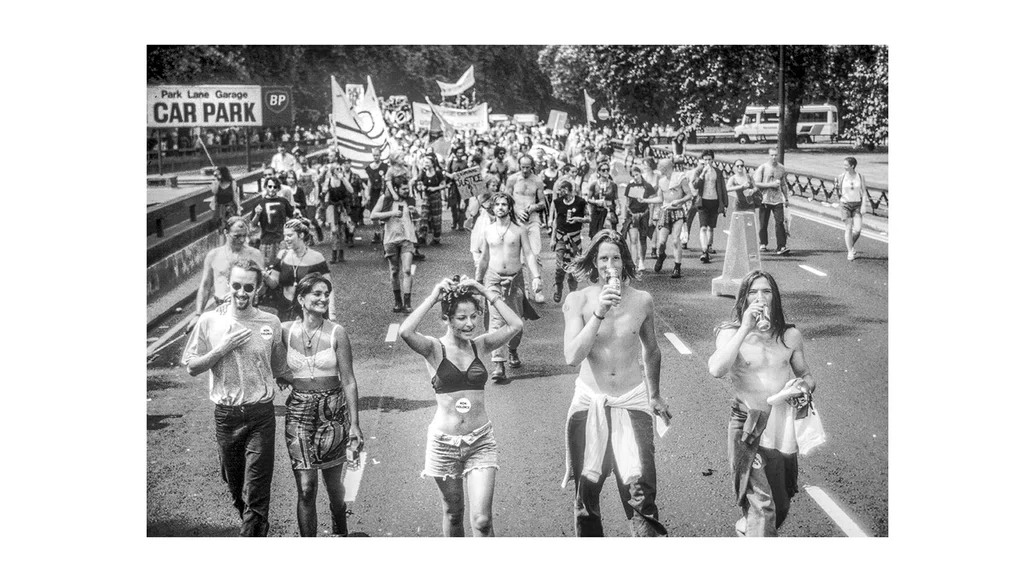
“It brought everybody from every background together, hugging on the dancefloor: barristers, window cleaners, teachers, nurses, football hooligans, all together, not giving a shit about what your background was or what your views were...” – DJ Graeme Park
DiY and Leeds band Chumbawamba collaborated on their ‘Criminal Injustice’ protest track, while electronicists Autechre put out the ‘Anti’ EP on Warp, a tune programmed to have non-repetitive beats, with profits going to human rights organisation Liberty. Dreadzone’s ‘Fight The Power’ was also released in ’94 to support Liberty in the fight against the bill, and was included on the ‘Taking Liberties’ compilation, which also featured music from Orbital, Galliano, Transglobal Underground, Test Dept, Loop Guru, The Orb, Ultramarine, Zion Train, Aphex Twin under his Caustic Window moniker, and The Shamen. And although Liam Howlett later denied it, it’s hard not to read The Prodigy’s ’94 album ‘Music For The Jilted Generation’ — with its inside sleeve art depicting a raver giving the finger to the police while heading off to a rave, and its ‘How can the government stop young people having a good time fight this bollocks’ sleeve-notes — as a very clear reaction to the bill.
DJ Graeme Park remembers the CJB well: “Ecstasy and acid house meant that you just could not stop people wanting to carry on enjoying themselves communally,” he tells DJ Mag. “It brought everybody from every background together, hugging on the dancefloor: barristers, window cleaners, teachers, nurses, football hooligans, all together, not giving a shit about what your background was or what your views were... With this stupid, ridiculous, reactionary, nonsense bill they were trying to stop a cultural revolution.”
Park recalls receiving a call from dance music aficionado Neil Rushton in early ‘94: “Neil was immediately on the phone, sharp as a knife, and he said ‘I want to do a quick compilation, ‘No Repetitive Beats’.’ I was like, ‘What a brilliant idea’.” Graeme mixed the ‘No Repetitive Beats’ compilation on Six6 Records, which included tunes from Inner City, Glam, Cool Jack and Terrence Parker. Royalties went to DiY’s All Systems No, a grass-roots response to the CJB from DiY and other UK systems.
Word about the CJB’s proposed wide-ranging powers spread rapidly through the counter-cultural underground. “We had an initial meeting with various sound systems from the East Midlands/Yorkshire area including DiY, Smokescreen, SPOOF, Pulse, Rogue, Babble and Breeze,” DiY’s Harry tells us. “We couldn’t believe what we were reading, that our way of life was being criminalised. All Systems No’s mission was to raise as much money as possible to fight the CJB, which resulted in us subsidising several coaches to the demos, printing tens of thousands of flyers and booklets to inform people, and the purchase of a ‘kamikaze’ rig which could be seized by the police without risking our own systems.”
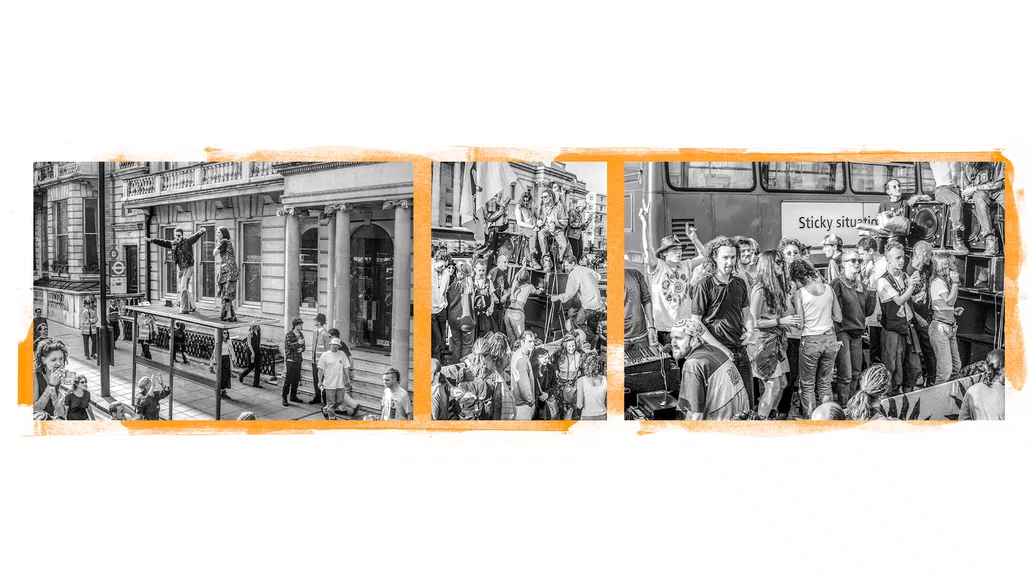
Two of the main organisations involved in the three large CJB London protests in 1994 were The Advance Party and The Freedom Network, a broad coalition of sound systems and party-goers, squatters, travellers, civil liberties groups, road protesters, hunt saboteurs and free party organisers. Photographer Matt Smith went with his Sunnyside sound system to the first two marches, and along with other sounds put on a free party on Wanstead Common after the protest. Matt and some friends had moved to Bristol from London in ’93, “with the express intention of opposing the legislation in as many ways as possible,” he says, “simply because we thought it was not right — and Sunnyside came together through that... We threw parties to raise money and raise awareness, using rave as a networking tool to entertain, amuse and inform and to create information dissemination. We ended up taking Bristol to London on a few occasions.”
The first big protest against the CJB, a march from Hyde Park to Trafalgar Square in central London organised by the Advance Party, took place on Saturday May 1st 1994 — May Day. This was soon followed by a second big mobilisation on July 24th, about twice the size of the first. The first two major protests were largely peaceful. “It was massively celebratory,” says Matt of the first one, “and we were full of naive zeal that we were going to change the fucking world.”
Matt, like many in dance music, had begun to think that just maybe change was possible, that perhaps this huge collective opposition might actually make a difference. Sunnyside parked their rig outside the National Portrait Gallery in central London. “A 10k rig on the back of a seven-and-a-half-tonne truck,” he remembers with a mix of delight and pride, “and that fucking moment when we turned the music on, the whole of Trafalgar Square turned round and roared at us like a football crowd — that was life changing.”
The third London protest took place on 9th October and, following the rally in Hyde Park, violence broke out after the police turned on the protesters with tear gas and horse charges. As the date for the bill to become law approached, there was a growing sense that the end was drawing near. Lol mentions reaching out to well-known and mainstream figures in dance music at the time. “Honestly, I gave it everything, we really fucking went for it, and I’m sure we did raise awareness a bit — but not enough,” he says. “DJ Mag, Mixmag, The Guardian and Melody Maker supported us but it would have been brilliant if we could have got more of the mainstream involved.”
Matt remembers Labour MPs Tony Benn and Jeremy Corbyn speaking at the first march, but ultimately Labour Shadow Home Secretary Tony Blair decided not to oppose the bill on its final reading, perhaps not wishing to damage Labour’s prospects in the next election by appearing soft on crime, and the CJA became law in November 1994.

“The BBC angle was ‘Everything finished with Castlemorton’, and I’m like ‘Bollocks did it!’ Ten years later there were probably more on Steart Beach than there were at Castlemorton.” – Matt Smith
The accepted narrative is that the act killed illegal raves, moving the scene into licensed venues where profits could be taxed, and closing times, noise levels and quantities of people controlled — and that this fostered the rise of superclubs like Cream and Ministry. As writer Ed Gillett in his excellent Party Lines book states, post-CJA, “UK dance music’s focus shifted to the booming market of superclubs and festivals — dancing not as a form of anti-social defiance, but a fully regulated leisure activity.”
Certainly the act had an immediate effect on the free party scene: in June ’95 a last-ditch attempt at a large-scale Castlemorton-style free party, the ‘Mother’ festival, was forcibly shut down by the police. But Gillett also notes that illegal events weren’t ending, they were “retreating into the shadows”, an important point echoed by several of our contributors. “The police had effectively militarised the South-West in England after Castlemorton,” Harry from DiY says, “so from the summer of ‘93 onwards there was no chance of another big free festival... but from being a huge social movement, the free festival/party scene simply went back underground.”
This is a key point in the CJA’s legacy, perfectly illustrated by how Matt spent the decade that followed. “I spent ten years running free parties throughout the ‘90s and early 2000s all over the country, and never got busted once!” he shares gleefully. “The last thing I ever really got involved with was the 10th anniversary of Castlemorton on Steart Beach in Bridgewater.” The Steart Beach rave, where a huge amount of sound systems — anecdotally, Matt heard it was forty-eight — played host to 16,000 people partying for a week. “The BBC angle was ‘Everything finished with Castlemorton’, and I’m like ‘Bollocks did it!’ Ten years later there were probably more on Steart Beach than there were at Castlemorton.”
Ironically, the protests against the CJB brought many disparate people together in a great cultural networking exercise that ultimately undermined many of the act’s anti-rave aims. “The repression by the state,” says Harry, “had the opposite effect to that intended in that it brought the systems together in a solidarity which endured.” Rather than completely ending illegal raves, the legislation simply meant that party organsiers brave enough to take the risk had to find new locations — often returning to cities and squat-parties — and new strategies to outfox the authorities. “I think the act might have temporarily pushed everyone deeper underground, but it didn't kill the spirit at all,” Simone tells DJ Mag. “It made the whole movement gain momentum and become stronger... it pushed it deeper underground and the roots spread. You might stop the party, but you can't stop the future.”
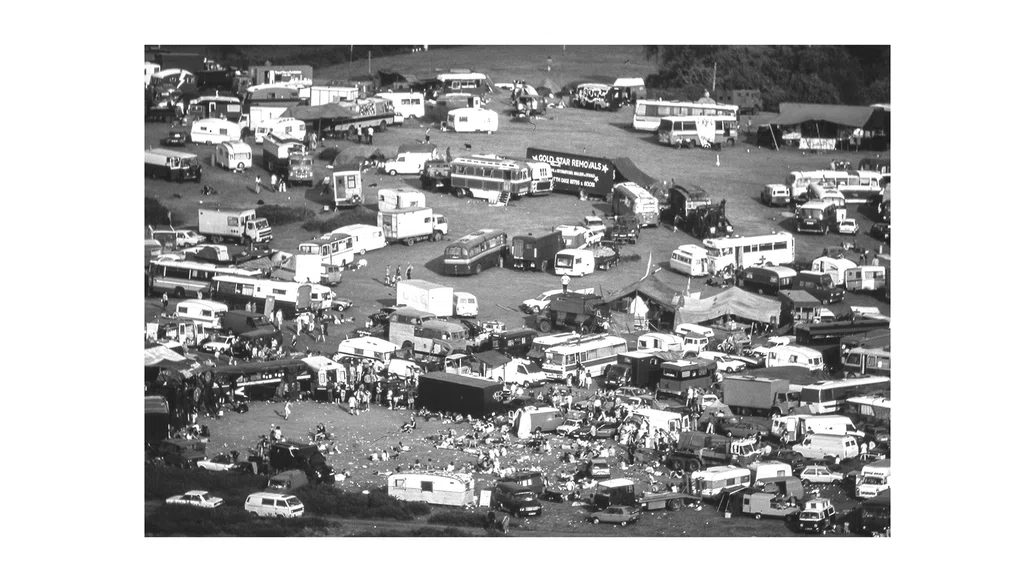
For many of the UK’s intrepid party creators, the party just relocated, as sound systems like Spiral Tribe, Desert Storm and Total Resistance moved to Europe and kick- started the Teknival movement. Others stayed in the UK, developing a strand of clubbing — including Lol’s Drum Club night, Megadog, Return To The Source, Tribal Energy, Megatripolis and Whirl-Y-Gig, amongst many others — which was dedicated to keeping the free festival ethos alive within licensed club nights.
It’s well worth mentioning that the post-CJA rise in legal dance music club culture wasn't inherently bad, of course; clubbing may have been more expensive and less wild than illegal raves, but there’s no doubt that the club nights that blossomed in the second half of the ‘90s — Metalheadz, Speed, Bugged Out!, Heavenly Social, Manumission, Stealth, Gatecrasher to name just a few — were absolutely world beating; and those that had started before the act, such as Cream, Trade, Slam and Back To Basics, all thrived in the second half of the decade too. As Matt notes: “The criminalisation of the big parties led to more developments in the legal club world... free parties are more of a lifestyle commitment, but by the 2000s everybody was raving and you had the Gatecrasher kids and all those incredible style tribes that came out of that late ‘90s superclub evolution.”
An unexpected effect of the act and the protests was their influence on what became the UK’s festival industry. Matt recalls doing a nationwide tour with a bunch of free party people at the time, many of whom now, like Chris Tofu MBE from Continental Drifts who currently oversees the Shangri-La area at Glastonbury, run the UK festival world. The illegal raves that were created from the unholy alliance between the travellers’ free festivals and the ravers’ parties contained the creative and practical DNA for our current summer-long festival season. As Harry says: “What had been dangerous and radical was sanitised, commodified and sold back to the people.”
Ultimately, if the CJA aimed to kill illegal raves, it failed. It certainly curtailed them, made the stakes higher for the organisers, and literally drove some UK sound systems out of the country. But as Spiral Tribe’s Ixindamix tells DJ Mag: “People will always party and celebrate, dancing to beats is an age-old human instinct. No matter what laws are created, people will always find a way to party together — it’s inevitable.
“Similar acts have been brought in around Europe,” she continues, “we’ve seen horrendous police violence directed at ravers in France, and at the moment there are particularly harsh laws in Italy promising long jail sentences for organisers — but the scene is so popular that people will always find ways around the rules, whether it’s finding cunning ways to elude the police, building ‘suicide rigs’ or simply having smaller events in remote places. The movement will continue.”




